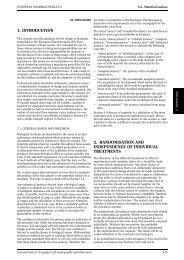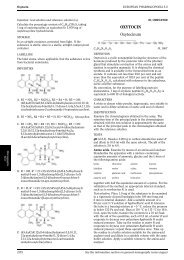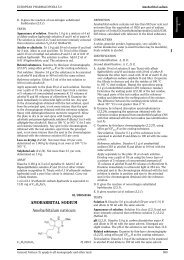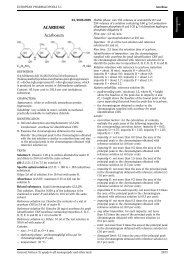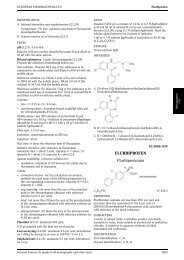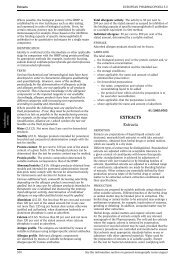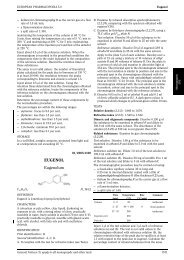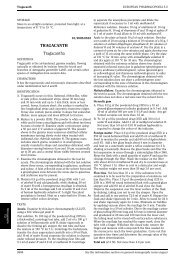AMFETAMINE SULPHATE Amfetamini sulfas
AMFETAMINE SULPHATE Amfetamini sulfas
AMFETAMINE SULPHATE Amfetamini sulfas
Create successful ePaper yourself
Turn your PDF publications into a flip-book with our unique Google optimized e-Paper software.
Amfetamine sulphate EUROPEAN PHARMACOPOEIA 5.0<br />
Flow rate: 1ml/min.<br />
Detection: spectrophotometer at 248 nm.<br />
Injection: 20µl.<br />
Sensitivity: reference solution (a).<br />
Run time: 3 times the retention time of the principal peak in<br />
the chromatogram obtained with the test solution.<br />
System suitability:<br />
— resolution: minimum of 4.0 between the peaks due to<br />
impurity B and ambroxol in the chromatogram obtained<br />
with reference solution (b).<br />
Limits:<br />
— any impurity: not more than the area of the principal<br />
peak in the chromatogram obtained with reference<br />
solution (a) (0.1 per cent),<br />
— total: not more than 3 times the area of the principal peak<br />
in the chromatogram obtained with reference solution (a)<br />
(0.3 per cent),<br />
— disregard limit: 0.1 times the area of the principal peak<br />
in the chromatogram obtained with reference solution (a).<br />
Heavy metals (2.4.8): maximum 20 ppm.<br />
1.0 g complies with limit test C. Prepare the standard using<br />
2mloflead standard solution (10 ppm Pb) R.<br />
Loss on drying (2.2.32): maximum 0.5 per cent, determined<br />
on 1.000 g by drying in an oven at 100-105 °C.<br />
Sulphated ash (2.4.14): maximum 0.1 per cent, determined<br />
on 1.0 g.<br />
ASSAY<br />
Dissolve 0.300 g in 70 ml of alcohol R and add 5 ml of 0.01 M<br />
hydrochloric acid. Carry out a potentiometric titration<br />
(2.2.20), using 0.1 M sodium hydroxide. Readthevolume<br />
added between the two points of inflexion.<br />
1mlof0.1 M sodium hydroxide is equivalent to 41.46 mg of<br />
C 13H 19Br 2ClN 2O.<br />
STORAGE<br />
Store protected from light.<br />
IMPURITIES<br />
A. Ar-CH 2OH: (2-amino-3,5-dibromophenyl)methanol,<br />
B. trans-4-(6,8-dibromo-1,4-dihydroquinazolin-3(2H)yl)cyclohexanol,<br />
C. trans-4-[[(E)-2-amino-3,5-dibromobenzyliden]amino]cyclohexanol,<br />
D. cis-4-[(2-amino-3,5-dibromobenzyl)amino]cyclohexanol,<br />
E. Ar-CH=O: 2-amino-3,5-dibromobenzaldehyde.<br />
<strong>AMFETAMINE</strong> <strong>SULPHATE</strong><br />
<strong>Amfetamini</strong> <strong>sulfas</strong><br />
01/2005:0368<br />
C18H28N2O4S Mr 368.5<br />
DEFINITION<br />
Amfetamine sulphate contains not less than 99.0 per cent<br />
and not more than the equivalent of 100.5 per cent of<br />
bis[(2RS)-1-phenylpropan-2-amine] sulphate, calculated with<br />
reference to the dried substance.<br />
CHARACTERS<br />
A white powder, freely soluble in water, slightly soluble in<br />
alcohol.<br />
IDENTIFICATION<br />
First identification: A, B, E.<br />
Secondidentification:A,C,D,E.<br />
A. The angle of optical rotation (2.2.7) ofsolutionS(see<br />
Tests), measured in a 2 dm tube, is −0.04 to + 0.04.<br />
B. Examine by infrared absorption spectrophotometry<br />
(2.2.24), comparing with the Ph. Eur. reference spectrum<br />
of amfetamine sulphate. Examineasamullinliquid<br />
paraffin R.<br />
C. To 50 ml of solution S add 5 ml of strong sodium<br />
hydroxide solution R and 0.5 ml of benzoyl chloride R<br />
and shake. Continue to add benzoyl chloride R in<br />
portions of 0.5 ml until no further precipitate is formed.<br />
Filter, wash the precipitate with water R and recrystallise<br />
twice from a mixture of equal volumes of alcohol R and<br />
water R and dry at 100 °C to 105 °C. The crystals melt<br />
(2.2.14) at131°Cto135°C.<br />
D. To about 2 mg add 1 ml of sulphuric acid-formaldehyde<br />
reagent R. An orange colour develops and quickly<br />
becomes dark-brown.<br />
E. Solution S gives reaction (a) of sulphates (2.3.1).<br />
TESTS<br />
Solution S. Dissolve 2.0 g in carbon dioxide-free water R<br />
anddiluteto100mlwiththesamesolvent.<br />
Appearance of solution. Solution S is clear (2.2.1) and<br />
colourless (2.2.2, Method II).<br />
Acidity or alkalinity. To25mlofsolutionSadd0.1ml<br />
of methyl red solution R. Notmorethan0.1mlof0.01 M<br />
hydrochloric acid or 0.01 M sodium hydroxide is required<br />
to change the colour of the indicator.<br />
Loss on drying (2.2.32). Not more than 1.0 per cent,<br />
determinedon1.00gbydryinginanovenat100°Cto<br />
105 °C.<br />
Sulphated ash (2.4.14). Not more than 0.1 per cent,<br />
determined on 1.0 g.<br />
966 See the information section on general monographs (cover pages)
EUROPEAN PHARMACOPOEIA 5.0 Amidotrizoic acid dihydrate<br />
ASSAY<br />
Dissolve 0.300 g in 30 ml of anhydrous acetic acid R.Titrate<br />
with 0.1 M perchloric acid, determining the end-point<br />
potentiometrically (2.2.20).<br />
1mlof0.1 M perchloric acid is equivalent to 36.85 mg of<br />
C 18H 28N 2O 4S.<br />
STORAGE<br />
Store protected from light.<br />
01/2005:0873<br />
AMIDOTRIZOIC ACID DIHYDRATE<br />
Acidum amidotrizoicum dihydricum<br />
C 11H 9I 3N 2O 4,2H 2O M r 650<br />
DEFINITION<br />
Amidotrizoic acid dihydrate contains not less than 98.5 per<br />
cent and not more than the equivalent of 101.0 per cent of<br />
3,5-bis(acetylamino)-2,4,6-triiodobenzoic acid, calculated<br />
with reference to the dried substance.<br />
CHARACTERS<br />
A white or almost white, crystalline powder, very slightly<br />
soluble in water and in alcohol. It dissolves in dilute<br />
solutions of alkali hydroxides.<br />
IDENTIFICATION<br />
First identification: A.<br />
Second identification: B, C.<br />
A. Examine by infrared absorption spectrophotometry<br />
(2.2.24), comparing with the spectrum obtained with<br />
amidotrizoic acid dihydrate CRS.<br />
B. Examine the chromatograms obtained in the test for<br />
related substances (see Tests). The principal spot in<br />
the chromatogram obtained with test solution (b) is<br />
similar in position and size to the principal spot in the<br />
chromatogram obtained with reference solution (b).<br />
C. Heat 50 mg gently in a small porcelain dish over a naked<br />
flame. Violet vapour is evolved.<br />
Reference solution (a). Dilute 1 ml of test solution (b) to<br />
50 ml with a 3 per cent V/V solution of ammonia R in<br />
methanol R.<br />
Reference solution (b). Dissolve 50 mg of amidotrizoic acid<br />
dihydrate CRS in a 3 per cent V/V solution of ammonia R<br />
in methanol R and dilute to 10 ml with the same solvent.<br />
Apply separately to the plate 2 µl of each solution. Develop<br />
overapathof15cmusingamixtureof20volumesof<br />
anhydrous formic acid R, 25volumesofmethyl ethyl<br />
ketone R and 60 volumes of toluene R. Allow the plate to dry<br />
until the solvents have evaporated and examine in ultraviolet<br />
lightat254nm.Anyspotinthechromatogramobtained<br />
with test solution (a), apart from the principal spot, is not<br />
more intense than the spot in the chromatogram obtained<br />
with reference solution (a) (0.2 per cent).<br />
Halides. Dissolve 0.55 g in a mixture of 4 ml of dilute<br />
sodium hydroxide solution R and 15 ml of water R. Add<br />
6mlofdilute nitric acid R and filter. 15 ml of the filtrate<br />
complies with the limit test for chlorides (2.4.4) (150 ppm<br />
expressed as chloride).<br />
Free aromatic amines. Maintain the solutions and reagents<br />
in iced water protected from bright light. To 0.50 g in a<br />
50 ml volumetric flask add 15 ml of water R. Shakeand<br />
add 1 ml of dilute sodium hydroxide solution R. Coolin<br />
iced water, add 5 ml of a freshly prepared 5 g/l solution<br />
of sodium nitrite R and 12 ml of dilute hydrochloric<br />
acid R. Shake gently and allow to stand for exactly 2 min<br />
after adding the hydrochloric acid. Add 10 ml of a 20 g/l<br />
solution of ammonium sulphamate R. Allowtostandfor<br />
5 min, shaking frequently, and add 0.15 ml of a 100 g/l<br />
solution of α-naphthol R in alcohol R. Shakeandallowto<br />
stand for 5 min. Add 3.5 ml of buffer solution pH 10.9 R,<br />
mix and dilute to 50.0 ml with water R. Theabsorbance<br />
(2.2.25), measured within 20 min at 485 nm using as the<br />
compensation liquid a solution prepared at the same time<br />
and in the same manner but omitting the substance to be<br />
examined, is not greater than 0.30.<br />
Heavy metals (2.4.8). Dissolve 2.0 g in 4 ml of dilute sodium<br />
hydroxide solution R and dilute to 20 ml with water R.<br />
12 ml of this solution complies with limit test A for heavy<br />
metals (20 ppm). Prepare the standard using lead standard<br />
solution (2 ppm Pb) R.<br />
Loss on drying (2.2.32):4.5percentto7.0percent,<br />
determined on 0.500 g by drying in an oven at 100 °C to<br />
105 °C.<br />
Sulphated ash (2.4.14). Not more than 0.1 per cent,<br />
determined on 1.0 g.<br />
TESTS<br />
ASSAY<br />
To 0.150 g in a 250 ml round-bottomed flask add 5 ml of<br />
strong sodium hydroxide solution R, 20mlofwater R,<br />
1gofzinc powder R and a few glass beads. Boil under a<br />
reflux condenser for 30 min. Allow to cool and rinse the<br />
condenser with 20 ml of water R, adding the rinsings to<br />
Appearance of solution. Dissolve 1.0 g in dilute sodium the flask. Filter through a sintered-glass filter and wash the<br />
hydroxide solution R and dilute to 20 ml with the same filter with several quantities of water R. Collectthefiltrate<br />
solvent. The solution is clear (2.2.1) andcolourless(2.2.2, and washings. Add 40 ml of dilute sulphuric acid R and<br />
Method II).<br />
titrate immediately with 0.1 M silver nitrate. Determine<br />
Related substances. Examine by thin-layer chromatography<br />
(2.2.27), using silica gel GF254 R as the coating substance.<br />
Test solution (a). Dissolve 0.50 g of the substance to be<br />
examined in a 3 per cent V/V solution of ammonia R in<br />
the end-point potentiometrically (2.2.20), using a suitable<br />
electrode system such as silver-mercurous sulphate.<br />
1mlof0.1 M silver nitrate is equivalent to 20.47 mg of<br />
C11H9I3N2O4. methanol R and dilute to 10 ml with the same solvent.<br />
Test solution (b). Dilute 1 ml of test solution (a) to 10 ml<br />
STORAGE<br />
with a 3 per cent V/V solution of ammonia R in methanol R. Store protected from light.<br />
GeneralNotices(1)applytoallmonographsandothertexts 967



